Shannon Reyes
self-professed collector of hobbies
5 FAVORITE RECIPES AirCorps Aviation restores aircraft from all over the world


self-professed collector of hobbies
5 FAVORITE RECIPES AirCorps Aviation restores aircraft from all over the world




Your joints areyourconnection points –and when they hurt, they stop youfrommovingfreely. That ’s whyour board- certified or thopedicspecialistsand surgeonsuseateamapproach to care foryoubefore,duringand af terjointreplacementsurgery. Ouradvancedpar tial or total jointreplacementoptions come withlessriskand shor terornohospital stays, so youcansafely restoreyourability to move





Ca ll (2 18)751-974 6tos ch ed ule anap po intm en t. No referral needed.














802 Paul Bunyan Dr. SE, Suite 19 Bemidji, MN 56601 218-333-9200
STAFF
Editor

Daltyn Lofstrom
Creative Director
Mollie Burlingame Advertising
Lindsay Nygren Business
Larisa Severson
ADMINISTRATION
Advertising Director
Todd Keute Editor
Annalise Braught Controller
Tammie Brooks
TO ADVERTISE 218-333-9200
James Hanson jhanson@bemidjipioneer.com
Questions and Feedback





 by MaryGrace Kerr inBemidji staff
by MaryGrace Kerr inBemidji staff


As fall approaches, so does cozy autumn fashion. Keep your small accessories such as necklaces, rings and bracelets organized with these adorable nature trinket dishes with a few simple ingredients you already have in your pantry.

+ 1 cup flour
+ 1/4 cup salt
+ 1/3 cup warm water
+ Small leaves, twigs or flowers


+ Sealant

+ Medium mixing bowl
+ Oven safe glass bowl

+ Paints
+ Paint brushes
+ Rolling pin
+ Parchment paper
Preheat your oven to 300 degrees.
Combine flour and salt in your mixing bowl. Add in the water while stirring continuously until a dough starts to form. If your dough is too dry add an additional tablespoon of warm water.

Knead the dough until it is a smooth and moldable consistency and divide into four equal portions.

Roll the dough to a 1/8-inch thickness. Place your twigs or leaves on top of dough and gently roll over them with your rolling pin.

Line a small oven-safe bowl with parchment paper and carefully place your clay imprint into the lined bowl, gently using your fingers to press the clay into the creases of the bowl. If you would like a smoother finish to your dish, dip your finger in water and use it to smooth the surface of the dish.
Bake in the oven for one hour or until the dough is fully hardened. Let the dish cool completely before removing it from the bowl and parchment paper.
Decorate your new trinket dish with paints or markers.



Add a coat of sealant to protect your project and allow it to dry completely.
Add your favorite accessories to your new little dish and enjoy!
Four Pines Bookstore, located in downtown Bemidji, has picked some recent releases for the fall edition of Bookmarked. These titles are perfect as the Bemidji area steadily cools and the leaves change hues, preparing us for more indoor reading. Check them out!




River We Remember

 By William Kent Krueger
By William Kent Krueger
The Taken Ones
 By Jess Lourey
By Pip Williams
By Lisa Jewell
By Loren Grush
By Jess Lourey
By Pip Williams
By Lisa Jewell
By Loren Grush
 By Ed Yong
By Ed Yong
As a Bemidji-based team of aircraft experts, AirCorps Aviation offers a full range of services to maintain and restore historic and legacy planes to aircraft owners and aviation enthusiasts all over the world.

Recently, the AirCorps Aviation team gathered in Oshkosh, Wis., in late July along with thousands of other aircraft enthusiasts for the Experimental Aircraft Association’s AirVenture, where planes of all kinds fly in from all over the world and competitions are held for restoration efforts.
The AirCorps business began in 2011 when four aviation restoration buffs Erik Hokuf, Eric Trueblood, Mark Tisler and
Dan Matejcek joined forces to do the work they love — restoring planes and preserving history.
From humble beginnings, the founders of AirCorps Aviation formed a dream so big it couldn’t be achieved until they grew into the thriving shop of over 50 employees who serve both the warbird and broader aerospace markets they are today.
“We went into our business in 2011 dreaming about being able to slowly chip away at building a better business and hiring and working with great people and for great people,” Senior Vice President of Sales and Marketing Eric Trueblood said. “Those things come together and they help you turn that dream into a reality.”
After their two most recent renovations — a P-51C Thunderbird and “Bonnie” the P-47 Thunderbolt — made their appearances known at the world-renowned convention, the AirCorps team’s long and meticulous restoration process brought home a couple of accolades after years of hard work including Grand Champion, Phoenix Award, Keep ‘em Flying and three Gold Wrench awards.
“It means a lot to everyone on the team to get to experience their hard work pay off,” Eric said. “It’s signified in the form of a wrench for craftsmanship, but we tried really hard to share the sense of accomplishment beyond the shop floor because you can’t do this type of work
without a whole culture of worldclass standards.”
But this isn’t the first time the AirCorps team came home with the gold. Since 2011, they’ve won numerous awards from AirVenture attributable to their services.


The Golden Wrench award dates back to 1965 when the Chief of Naval Operations wanted to acknowledge maintenance performances that go above and beyond the extraordinary effort that regular aircraft maintenance requires. And they did just that with “Bonnie” the P-47 Thunderbolt — a full restoration that took nearly five years to complete.
“We love challenges and problemsolving, so after five years spent on restoring this aircraft, it’s a relief to be done, but when you work on something for so long it becomes part of your life,” Eric said. “We’ve been walking around it, looking at it, thinking about it and planning it for so long, but one of the things I’m proud of is the fact that it was a quick restoration for its size and complexity compared to other projects.”
The man behind the controls that flew P-47 Bonnie in the war was Brigadier General William “Bill” Dunham. The plane carries the namesake of the love of his life — a woman named Bonnie Harris.
As Commanding Officer of the 460th Fighter Squadron, 348th Fighter Group, a Triple Ace and a career in the Air Force from 1920 to 1990 along with the decoration of various awards from the Distinguished Service Cross to the Air Force Commendation Medal — Dunham was no doubt a war hero.
While Dunham flew in the South Pacific, Bonnie became a nurse as she waited for her hero to return. They married during the last year of the war and went on to start their 30year life in the Air Force. As the wife of a Brigadier General, Bonnie’s life was full of travel, glamor, responsibility and opportunity she never would have imagined.
Throughout his life in the Air Force, Dunham had the “Bonnie” namesake emblazoned on all three of his P-47 planes.
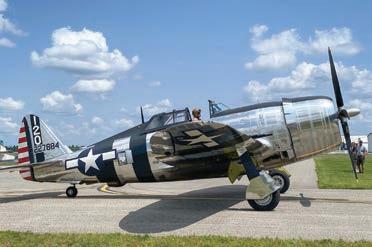

According to the AirCorps team, “Bonnie” is just one example of the romantic history that a World War II-era aircraft can represent.

While AirCorps strives to provide world-class parts and restoration services to customers all over the world, they also work hard to put more out into the warbird industry than they take from it by keeping the history of these aircraft alive. The goal is not just to restore the planes, but to uncover the story behind each one.

“It’s one of our values here at AirCorps — preserving history and telling the stories of World War II,” General Manager Erik Hokuf said. “No matter what airplane our customer chooses to have us restore, we’re going to get into it, get excited about it and dig into the history.”
Flying beyond the more traditional restoration services like fabrication, maintenance and parts departments, AirCorps recently expanded the scope of their capabilities with departments in reverse engineering, history libraries and art to assist the complex needs of their customers.
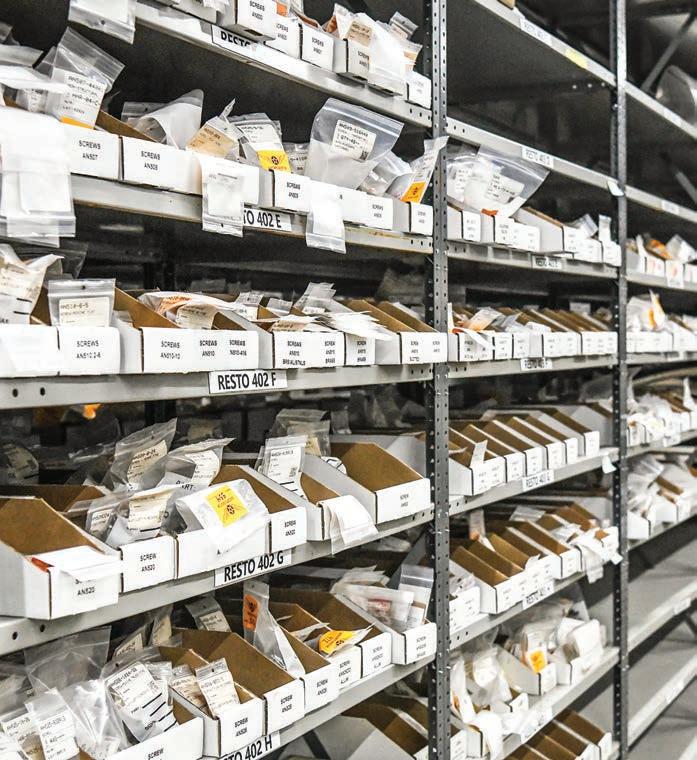
“There’s people that will come up and be really passionate about the technical side of things,” Eric explained. “But I would say that the airplanes are always going to be really romantic because we’ll never build airplanes like this again”
He explained that the broader audience and customers are always very interested in the rarity and technical side of things.
“But I think they’re more motivated by the story,” Eric added. “We have a historian working with us who researches and writes the stories to go along with the planes and because these are projects that take a while, we want to keep the enthusiasm up in today’s world chaos.”

Although resurrecting some of the rarest pieces of American history and getting them back up in the air is an accurate representation of their passion, in the words of Erik, AirCorps Aviation is much more than just a restoration shop.
He said that each combat aircraft were everyday companions to airmen in World War II and represent symbols of their courage and sacrifice. Whether it’s a bomber, fighter or transport plane, each holds its own story and legacy — just like Bill and Bonnie.

“No matter what airplane our customer chooses to have us restore, we’re going to get into it, get excited about it and dig into the history.”
-Erik HokufThousands of P-51 Mustang parts, as well as other aircraft parts, are stored in an AirCorps Aviation warehouse in Bemidji. Photo by Madelyn Haasken
“We are multipronged in that the story reaches way beyond the amount of horsepower, armor or number of guns the aircraft has,” Erik said. “The individuality of each project along with uncovering the story of who these people were that flew these planes in World War II is just as important as restoring them.”

Working in the world of World War II-era aviation restoration may seem like it would be a hard skill to come by in a small town in the Northwoods — but AirCorps doesn’t see it that way.


To them, that just expands the potential to teach more people to learn the skills of building, restoring, maintaining and repairing aircraft.
Most of their employees are locals who picked up the skills it takes to restore an airplane along the way. Others traveled to Bemidji from all parts of the world to pursue their aviation passion.

“We’re attracting people at a global level who aspire to do that type of restoration work to the community here and we’re proud of the people that we’ve brought to the area,” Erik said. “And I think that starting this business in Bemidji has paid off for us because this is a place where there are people that know how to build things and want to do this type of work.”
While hiring an employee,
Eric and Erik don’t just look at their past aviation experiences. They look for skills that most trade professionals, like construction workers, plumbers, electricians and other technicians, have instilled in them already.
“You have to have a culture of people that aspire to do this kind of work and that align with the standards you’re looking for. It can be demanding, but it can also be really gratifying,” Erik said, “and we have those people here. People who are looking for a challenge, who are selfmotivated and problem solvers.”
Inside the hangar, professionals of all different backgrounds and experiences come together with a common goal — preserving and telling the story of World War II.
AirCorps Aircraft and Powerplant Mechanic Aaron Prince has been working with planes since he was 16 years old. Hailing from Pennsylvania, he always knew he wanted to pursue a career in aviation.
“I worked at another restoration shop when I was in college,” Aaron said. “I got to the point of graduating and searching for jobs and I said ‘screw it, I’m going to apply to the best restoration shop in the country’ and AirCorps Aviation sent me an offer and I packed up all my things and moved from Pennsylvania to Minnesota.”
On the other hand, Restoration Specialist Randy Kraft had no prior experience

when he started at AirCorps. However, qualities like dexterity and attention to detail he generated in his past profession as a carpenter set him up for a successful career in aviation.
“I didn’t know anything about airplanes when I started. But (AirCorps) is very accepting and they know they’re going to have to teach their employees these things,” Randy said. “Of course, the construction background definitely helps with learning this process like reading the drawings and a general understanding of building.”
Erik has witnessed many employees, like Randy, come in with no experience and with time, grow into masters of their trade of preserving airplanes. To him, that’s one of the most rewarding parts of his job.
“We have the type of people who have grit, work hard and never give up. They have those values instilled in them already,” Erik said. “For me, one of the most rewarding parts is seeing people grow here. I look back and I can see some faces in my head of people who had never pictured themselves working in this unique trade and now they’re preserving planes at a world-class standard.”
As AirCorps continues to grow worldwide, take on more intricate restorations and piece history back together, the team hopes people will become more familiar with some of the modern-day advancements they’ve made in the world of aviation.
“When you think about the World






War II era, it’s very romantic, interesting and something we’re well known for, but we’ve also made a lot of the parts that go into Delta airliners,” Eric said. “We recently did free Wi-Fi and parts in commercial flights and we’ve got parts going up that are going through the military for modern jets.”
According to Erik, AirCorps always has a lot of prospects on the horizon and will continue to bring more talent into the community.
“There’s lots of big projects, always. There are so many things that are going great for us and we’re just going to continue to grow,” Erik said. “There’s still lots of opportunity in front of us and lots of opportunity for our community and I think you’ll see the dynamics of AirCorps continue to play out in the region.” ▪
“When you think about the World War II era, it’s very romantic, interesting and something we’re well known for, but we’ve also made a lot of the parts that go into Delta airliners.”
- Eric Trueblood






 by Daltyn Lofstrom inBemidji editor | photos by Maggi Fellerman
by Daltyn Lofstrom inBemidji editor | photos by Maggi Fellerman
Shannon Stormy Reyes is a selfprofessed collector of hobbies.
But just as eclectic is her range of experiences that have led her to the Bemidji area and a spot in her life where no day ever looks the same as yesterday. During the summer, her Mondays
always involve painting. Moving into Tuesday and beyond, she’ll play hopscotch between her plethora of crafting and scientific activities that occasionally make it difficult for her to make sense of all the chaos.
“Right now, I’m living on caffeine
and a dream,” Shannon reflected while sitting on her porch, a popular painting site strewn with supplies and canvases in varying stages of completion. “I kind of collect hobbies. That’s my thing. I do them all, though. It’s not like they sit in a drawer, so I feel OK about it.”

Her original artworks can be seen hanging on the walls inside her home. Sometimes, her paintings are based on photographs that she recreates through her brushstrokes, adding in some artistic liberties to truly make them her own; other times, her inspiration will come after she brings pigment to parchment.



Traces of her other pursuits can be found throughout her abode, adding character with each step a person takes and in every direction they look.
Having led a mushroom foray (a guided hunt) at Movil Maze in early August, lobster mushrooms – a reddish-orange in color – lay on paper towels on her kitchen counter as she jumps at every opportunity to learn more about the natural world. She has learned to identify about 25 types of mushrooms over the past few years.
Shannon remains involved in the Paul Bunyan Mushroom

Club, now a chapter of the Minnesota Mycological Society that’s committed to the study of mushrooms and other fungi. According to their website, MMS members work with professional mycologists to improve their mushroom identification skills, build a mycological collection at the University of Minnesota and educate the public about fungi.

Along with these forays, Shannon grows tomatoes on her property as part of the University of Minnesota Extension Office’s Master Gardener volunteer program. This allows her to collect scientific data surrounding horticultural practices.
Shannon’s natural curiosity shouldn’t come as a surprise to anyone who has crossed paths with her. “Learner” is her top CliftonStrength, which has served her throughout her life.
“I teach myself and I like to learn,” Shannon added, “and I do like teaching.”


“I teach myself and I like to learn, and I do like teaching.”
- Shannon Reyes
Originally from Chicago, Shannon’s artistic endeavors started in high school with a couple of art and photography classes.


“I was like, ‘Man, this is what I want to do,’” she recalled. “I took photography back in the day when you actually developed film. That was one of my favorite things and I wanted to be a National Geographic photographer, go sit in a hut and take pictures.”
After graduating high school, she had a decision to make. She looked into art school, but concluded that it just wasn’t financially feasible at that time in her life.



“My parents didn’t have any money. I didn’t have any money,” Shannon said. “I didn’t want to pay $45,000 for school, so I joined the military.”

Shannon completed basic training in San Antonio, Texas, after which she served for nine years on active duty as a laboratory technician and six years with the Minnesota National Guard in electrical power production.



Surpassing national borders, Shannon lived in western Germany for three years before moving to Bemidji, which she has called home since 2013.
“(Living in Germany) is kind of why I fell in love with this place,” Shannon said regarding Bemidji. “It is a lot like Germany with lots of woods, lots of trees … but nobody told me about the winters (in Bemidji).”

Settling into blizzarding Bemidji, Shannon came to the realization that the time was right to pursue higher education once again. She enrolled at Bemidji State University where she would eventually earn her bachelor’s degree in biology.



Naturally, she opted to take a couple of art classes interspersed with her science. Working through post-traumatic stress disorder from her time in the military, she received Fs in these classes, though such grades would hardly represent the work she puts forth to this day.
“Color Theory was probably my favorite class,” Shannon said, expounding

on the knowledge it has given her. “It has helped me figure out how to put a painting together and help the colors vibrate off each other. One painting I have changes with the light; as the light goes down, you can still see it. I’ve started playing more with lights and color.”
Brainstorming her next goal after graduating from BSU, Shannon had loftier goals to work at Penn State or Mayo Clinic in regenerative or longevity research.
Starting more locally, she pursued student teaching with Bemidji Area Schools. On the cusp of completing her student teaching, March 17, 2020, presented an unprecedented development
with the onset of the coronavirus pandemic.

“We get a message, ‘Hey, we’re going home…,’” Shannon recalled. “I had six weeks left at the high school and another four weeks at the middle school I was supposed to do, but then there was COVID and everybody went home.”
Creating video worksheets and instructing through a computer screen certainly wasn’t Shannon’s idea of being a classroom teacher. However, such difficulty gave way to a silver lining that has evolved over the past three years.

“It was kind of a depressing time,” Shannon said, “but that’s also when I started painting again.”

Titled after her first and middle name, Shannon Stormy LLC was officially incorporated during the pandemic. Underneath the vast umbrella of the business is her paintwork, macrame, lip balms, salves and lotions, bath bombs, handmade paper, homemade soap, foraging and introductory beekeeping –nearly all of which are self-taught.
On her decision to become an LLC, Shannon explained, “If I sell chapstick or give somebody some soap … if they sue me because they have an allergic reaction, they can’t take the house. That’s why you go LLC versus sole proprietor.”
As she added to her repertoire, she continued teaching in the classroom for some time. While out of the career field as a math teacher at Voyageurs Expeditionary School in 2021, Shannon exercised her green thumb at the helm of a student gardening project at the school where students could grow their own plants, fruits and vegetables.
Starting with the 2021-2022 school year, Shannon transitioned to chemistry and physics teaching in Bagley. Once

this past February came around, she was at a crossroads with burnout from her teaching during the pandemic and the ever-increasing activity of her business.



As such, another decision had to be made.
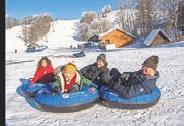

“Things got so bad that one day, I called my principal and said, ‘You need to get somebody down here. I’m not doing this anymore,’” Shannon mentioned. “So, I just walked out and was like, ‘What do I do now? Well, I’m gonna do my art.’”



Fully dedicating her time to her passions, she continues to teach others – just in a different way. Offering craft parties and classes in the Bemidji area, Shannon draws some parallels between her current role as an educator within her business and teaching at a school.

“It’s just so different. People (at craft parties and classes) actually want to be there versus trying to do this at a school. I made bath bombs with the kids in school and the boys ended up throwing them in the toilets,” Shannon said.
“Well, at least the toilets smelled nice.”
The concept of combining art with science is one that Shannon observes through much of her work. Her porch displays painted rocks, one lettered with, “Never trust an atom. They make up everything.”
“I always started the class with a science joke, like a really stupid, nerdy science joke,” Shannon reminisced from her time in the classroom. “Another one is, ‘I was reading a book on gravity last night, and I couldn’t put it down.’ I had a deck of dad joke cards from TJ Maxx and the kids loved that.”
While she enjoys painting the most, teaching herself how to do other things prevents her from ever getting bored. Creative challenges do arise and when they do, it’s easy to take a much-needed brain break.
“Being creative all the time, there are some times that you’re uninspired,” Shannon said. “That’s why I do all these different things. I may say, ‘I don’t feel like doing art today.’ So I’ll go for a four-to-five-hour walk in the woods, get lost and find some mushrooms or identify some berries.”
Upon returning to her makeshift art studio on the porch – moving indoors during the winter – gifting art to others is the most rewarding part of it all.
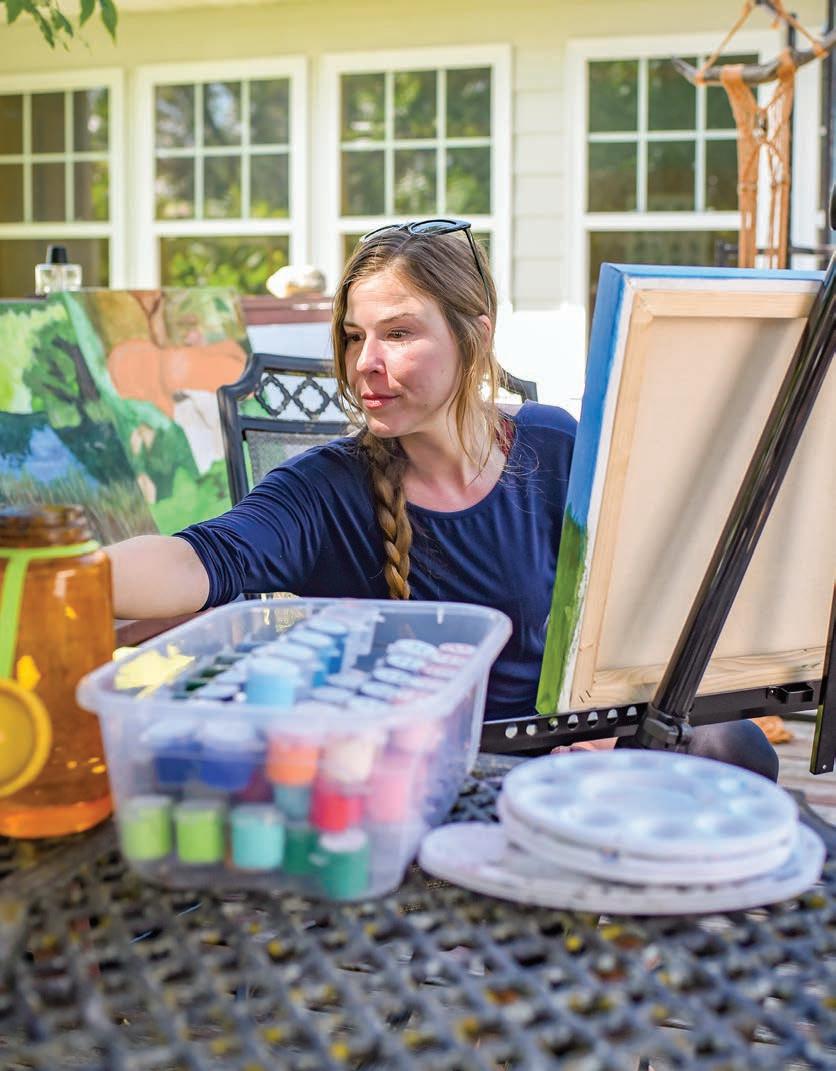
“I just like creating, actually putting something out there even if I don’t sell it yet,” Shannon said. “Van Gogh didn’t get famous until after he died, so it’s like leaving a mark with people who like what I do.”
Moving into the future, Shannon will be a featured artist at Gallery North in Bemidji for October and hopes to teach classes at Headwaters Music and Arts.
In terms of art projects, she hopes to attain a buck or deer via bow-hunting and paint a mural on its hide. She also wishes to lead a potential mural-painting project at Bemidji Brewing pending grant funding.



Launching a website and being active on her Facebook and Instagram pages –ShannonStormyLLC – will remain an important part of marketing herself to the public, as well.
Honing community connections will serve her purpose perpetually.
“When people are having fun doing art, that’s really rewarding,” Shannon left off. “That’s the goal.” ▪

For this edition of inBemidji, Larisa takes us back to some of her favorite recipes she’s cooked up in her kitchen over the last few years from past magazine issues. From chocolatey cupcakes and pumpkin bread to tasty flatbread pizza and pasta, we hope you enjoy these delicious dishes whether you’re bringing them back into rotation or trying them for the first time this fall.

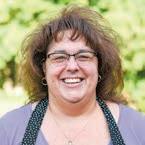



Ingredients:
Filling:
1 8-ounce package cream cheese, at room temp
1 unbeaten egg
1/2 cup sugar
1/8 teaspoon salt
1 12-ounce bag miniature semi-sweet chocolate chips
Cupcake batter:
1 1/2 cups flour, sifted
1 cup sugar

1/4 cup cocoa powder
1 teaspoon baking soda
1/2 teaspoon salt
1 cup water
1 teaspoon vinegar, white
1 teaspoon vanilla
Cool Whip Cream Cheese Frosting:
12 ounce Cool Whip, thawed
8 ounce cream cheese, softened
3 tablespoons powdered sugar
1 teaspoon vanilla

Directions:
Filling: In a small bowl, mix all ingredients together and set aside. Line cupcake tins with paper cups and fill half full with cupcake batter and top with approximately one teaspoon of the cream cheese filling. Bake at 350 degrees for 20 minutes.
Cook’s notes:
If you don’t want to make the cake mixture from scratch, a Devil’s Food cake mix works great. Just follow the directions for preparation on the back of the box, just adding one teaspoon of vanilla. To ensure your cupcakes are the same size and have the same amount of filling, use a medium-sized ice cream scoop for the cake batter and a smaller melon ball-sized one for the filling. Frosting the cupcakes is optional. You could also opt to dust them with powdered sugar or enjoy them plain.
Ingredients:
3 pounds ground beef
4 16-ounce cans chili beans in hot chili sauce
2 16-ounce cans dark red kidney beans, drained and rinsed
2 16-ounce cans diced tomatoes

2-3 cups bold & spicy bloody mary mix
3 teaspoons chili powder
3 teaspoons black pepper
3 teaspoons garlic powder
3 teaspoons onion flakes (or 1 medium chopped onion)
4-5 dashes hot sauce (optional)
1 diced jalapeno with seeds (optional)
Directions:
Place the ground beef in a large pot, add jalapeno, onion or onion flakes and brown over medium heat until completely browned. Drain off the excess fat and add the rest of the ingredients. Mix together well, cover and reduce the heat to low. Simmer for two to three hours, stirring occasionally. If chili seems too thick add an additional half cup of Bloody Mary Mix to thin it out and let simmer for an additional half-hour.
Garnish with diced green onions, sour cream, shredded cheese and Fritos.


Ingredients:

1 tablespoon olive oil



1 pound chicken breast, diced
Salt and pepper, to taste
1/2 cup onion, diced
2 cloves garlic, minced

1 teaspoon Italian seasoning
1 tablespoon fresh parsley


14 1/2 ounces diced tomatoes, drained
3 cups chicken broth, plus 1/2 cup extra, if needed
1 cup heavy cream
12 ounces penne pasta

2/3 cup mozzarella cheese
1/2 cup parmesan, divided

Directions:

Season chicken with salt and pepper. Heat olive oil over medium heat and cook chicken until no pink remains. Set aside. Add onion and garlic to the pan. Cook until the onion is tender, about 3 minutes. Add seasoning, parsley, 3 cups broth, tomatoes and cream and bring to a boil. Add pasta. Let simmer for about 15 minutes or until tender and thickened. If you need, add 1/2 cup broth until pasta is cooked. Mix in 1/4 cup parmesan cheese. Add the chicken back to the skillet, top with mozzarella cheese and remaining 1/4 cup parmesan, then broil 2 to 3 minutes or until cheese is melted and golden.



Ingredients:
Pumpkin batter:

1 cup pumpkin puree
1 large egg
3/4 cup light brown sugar
1/4 cup oil
1/4 cup sour cream
1 teaspoon vanilla extract
1/2 tablespoon pumpkin pie spice
1 cup flour
1/2 teaspoon baking powder
1/2 teaspoon baking soda
1/4 teaspoon salt
Cream cheese filling:
1 large egg
4 ounces cream cheese, softened
1/4 cup granulated sugar
3 tablespoons flour
Directions:
Preheat the oven to 350 degrees. Grease a 9x5 loaf pan with cooking spray and set aside.
In a large bowl, combine pumpkin,
egg, brown sugar, oil, sour cream and vanilla extract. Fold in the pumpkin spice, flour, baking powder, baking soda and salt until just combined.
Pour 2/3 of the batter into the prepared pan.
In a medium bowl mix all the cream cheese filling ingredients together until smooth. Pour the cream cheese filling on top of the batter, spreading it out gently with a spatula. Pour the remaining pumpkin batter on top, carefully spreading it as well.
Bake for 45-50 minutes or until a toothpick comes out mostly clean. Cool in the pan for 15 minutes before moving to a wire rack to cool completely.
Ingredients:
2 flatbread slices
2 cups shredded monterey jack cheese
1 cup shredded cooked chicken
Peanut sauce:
1 tablespoon soy sauce

2 tablespoons water
2 tablespoons brown sugar
1 tablespoon lime juice
1 teaspoon soy sauce
2 teaspoons peanut butter (optional)
1/2 teaspoon sriracha or Asian hot chili sauce (optional)
1/2 teaspoon garlic powder
1/4 teaspoon each ground ginger, salt, pepper
Crema sauce:
11/2 tablespoons mayonnaise
1/2 teaspoon sriracha
1/2 teaspoon lime juice
Optional toppings:
1/2 small red onion, thinly sliced
1/2 cup white bean sprouts
1/4 cup matchstick carrots
Directions:
Crema: Whisk all the ingredients together in a medium bowl until smooth. Store in the refrigerator.
Peanut sauce: Whisk all the ingredients together in a medium bowl except for the
peanut butter. Set aside. Heat oil over medium high heat in a large nonstick skillet. Add shredded chicken to pan and heat through. Add prepared peanut sauce (except for peanut butter) and simmer with chicken for two minutes. Stir in peanut butter until smooth and completely combined (optional). Evenly spread shredded cheese on flatbread then divide chicken and peanut sauce between the two flatbreads and spread almost to edges. Add any of the optional topping ingredients on each of the flatbread and sprinkle with extra cheese if desired. Bake for 10 minutes in a 400 degree preheated oven until cheese is melted and golden brown. Drizzle with crema before serving.
Hours: Sun-Thurs: 11am-9pm Fri-Sat: 11am-9:30pm | Lunch: Mon-Fri: 11am-2pm


AGE: 49


OCCUPATION:
Construction safety trainer and yoga instructor


WHERE WE FOUND HER: Teaching our yoga class at Bar 209
Editor’s Note: Writer Jennifer Koski believes everyone has a story to tell — from the person in line behind you at the coffee shop to the person who delivers your mail. After 12 years of proving this theory with her award-winning “Random Rochesterite” magazine column in Rochester, Minn., now a Bemidji transplant, Koski is bringing these person-on-the-street interviews to inBemidji.
+ HAVE YOU ALWAYS LIVED IN THE BEMIDJI AREA? No.


My mom’s family is originally from Bagley, so I spent a lot of summers in northern Minnesota growing up. But I was born in Omaha, Nebraska. My dad was in the Air Force, so I lived in a lot of different places.


+ FAVORITE PLACE YOU LIVED GROWING UP?
Germany. We lived in Stuttgart for three years when I was five, six, seven years old. I have good memories from there of going to school with all of the kids from the base.
+ WHERE ELSE DID YOU LIVE? We were in Colorado for two years, then Indiana for four years and then to Mitchell, South Dakota — and that was a big one. I was in between seventh and eighth grade when we moved there, and that was hard. Then we moved to Montana when I was in high school and that was easier. I’ve been in Minnesota for 25 years now and that’s the longest I’ve lived anywhere. I moved to the Minneapolis area in 1997 to go to school and I ended up staying there.
+ WHAT BROUGHT YOU “UP NORTH”? Pretty much COVID. In October 2019, I opened an art studio in St. Cloud — we were living in Becker then — and by March 17, 2020, we were shut down. We had to close since we weren’t an essential business. We had a cabin here, and my mom had moved back to Bagley after my dad passed away, so we moved up in December 2020 and have been here ever since.
+ FAVORITE PART OF LIVING HERE? Being closer to family, for sure. I have a huge extended family — 22 first cousins — and most of them live in this area.

+ HOW LONG HAVE YOU BEEN TEACHING YOGA?
Since 2018. I traveled all over the United States with my job in construction safety training. I wanted to stay active while traveling, and yoga was the one thing I could do in my hotel room. Eventually, I wanted to get out of construction and I
wanted to get deeper into my yoga practice. So I took teacher training at Core Power Yoga in Minnetonka.
+ AND YOU DON’T ONLY TEACH, BUT YOU STARTED THE YOGA STUDIO, TOO, RIGHT? I always had the idea that I wanted to do something with yoga to give back to the community and I wasn’t sure how to do that. So I started this studio knowing it was going to take a different path. I wanted it to feel like a cooperative, where everybody is part of it. I wanted it to feel like home for a bunch of people. I explored options and talked to other studios and realized that becoming a nonprofit was the best way to do that.
+ WHAT’S BEEN THE BIGGEST REWARD? The amount of yoga that we’ve brought to this community in the past six months is incredible. The outreach we’ve been able to do in a short time. We do so many classes. We just did a class for the ADHD and autistic group at TrekNorth School.
+ AND THE BIGGEST CHALLENGE? It’s really just helping people understand what yoga is — that it’s a mental and physical health practice. It’s not a religion. It’s not just meditation. It really is for every “body” — anyone can get the physical and mental benefits. We have people who take yoga every day because they’ve been in a car accident. We have people who come in because their therapist recommends yoga to calm their minds or for selfcare.
+ LAST SONG YOU LISTENED TO? I just had Fleetwood Mac playing on my phone. The Rumours album is my favorite.
+ BEST CONCERT YOU’VE ATTENDED? That’s Fleetwood Mac, too. In St. Paul the last time they were there.
+ BIGGEST ADVENTURE? My mom and I just went to Scotland for two weeks. Amazing. My mom is a McCollum and I’m a McCormick, so we saw both of our family castles. It was super
cool. I love to travel. I have 14 states left to go to get all 50 in. Next up is Maine.
+ SCARIEST THING THAT’S HAPPENED TO YOU? I was in a car accident. It’s the only one in my entire life, and it was just two years ago. I was driving to meet my mom at Red Stu for breakfast on a Saturday morning,
and someone took a left turn into my car. She hit me hard — ripped my door off and I spun around. I was scared, in shock and hurt and it totaled my car, but I was OK. I had bruises from the airbags, but fortunately, I had turned my head, so the airbag didn’t break my nose. Before that, my scariest moment was when my daughter

got into a car accident when she was 16. I got a call that she’d been in an accident and went to her, and when I came up the hill I saw all of these firetrucks and ambulances, and I saw that they had my daughter on a backboard. I was a mess. A firefighter stopped me and said, “You have


to calm down if you’re going to go talk to her.” It’s amazing how fast your life can change. But she was lucky, too.
+ WHAT MIGHT I BE SURPRISED TO LEARN ABOUT YOU? I started my first business when I was 23 years old. It was called Food 2 U. I
went to different restaurants in my community — a Subway, a Chinese restaurant, a steak joint — and I got them to sign contracts to work with me. It was like Uber Eats way before cell phones. You’d call the restaurants to order, and then they’d page me to pick up the food, and I’d add on a delivery fee. It grew so fast. I started it in October and by March I sold it to the taxi company in town.
+ YOU’VE ALWAYS HAD AN ENTREPRENEURIAL SPIRIT? I think so. I’ve always worked 80 hours a week just so I didn’t have to work 40 for someone else.

+ IS THAT HOW YOU BECAME A SAFETY TRAINER? I was in the construction industry as a laborer and wanted to not be a laborer anymore. So I took safety classes to do OSHA and MSHA safety training. I started with on-site safety first, then in-field training and auditing. I made sure everyone was doing what they were supposed to be doing — so I was everyone’s favorite person! The
last classes I taught, though, were in March. I’m taking a break to focus on The Yoga Studio, to make sure this non-profit is successful.
+ WHAT’S SOMETHING YOU’RE PROUD OF? We’re already expanding the studio. We’ve been open less than a year and just moved to the south end of the CrossFit building to have space for more classes and outreach.

+ ADVICE YOU’VE GIVEN?
Travel as much as you can. My son just packed up and moved to Montana last year, so he took it very seriously!
+ ADVICE YOU’VE BEEN GIVEN? I was really fortunate to have great managers when I was a kid. One of my first jobs was at Subway, and the people who owned it told me to work in their restaurant as if I owned it. I’ve always remembered that. Because customer service is so important. If you work anywhere, treat that job as if it’s your own business and you’ll be a better employee. ▪
The trick-or-treating tradition is kept alive each Halloween in the dorms of Bemidji State University and throughout the area as children—and even some adults—don their costumes to collect candy. Can you spot 6 differences between these two photos from last year’s festivities?
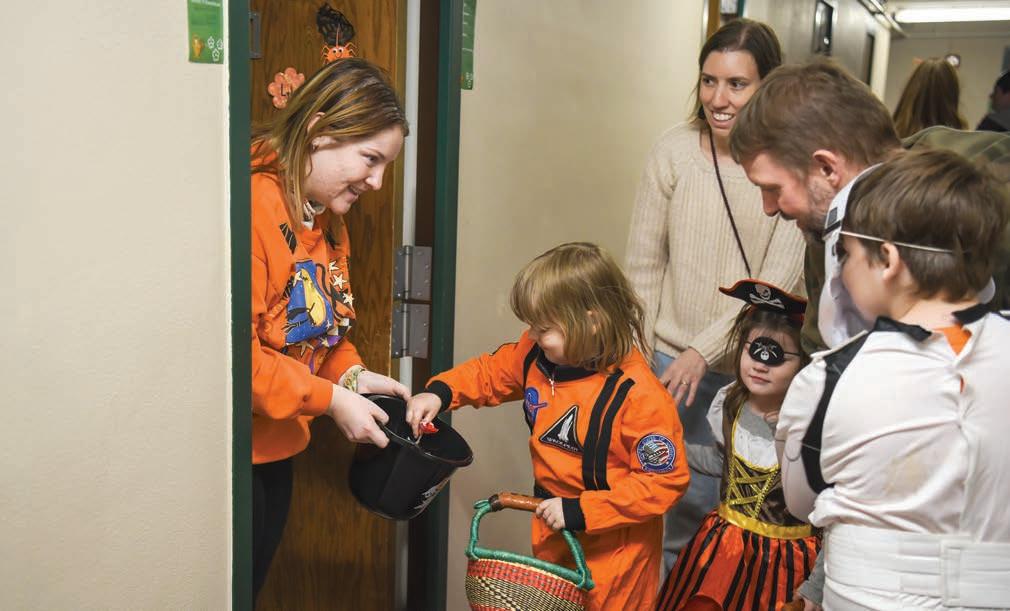
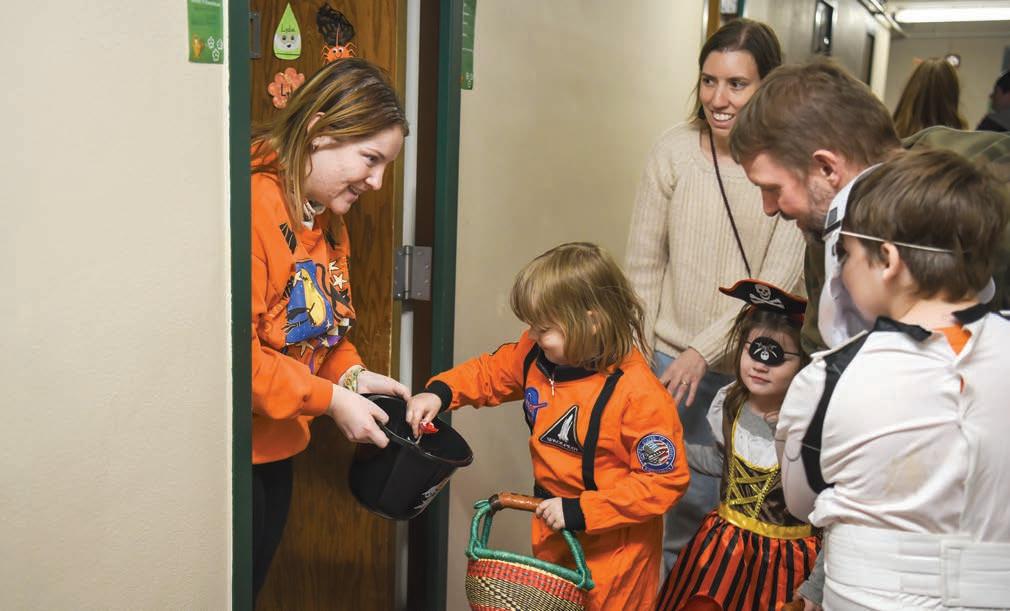




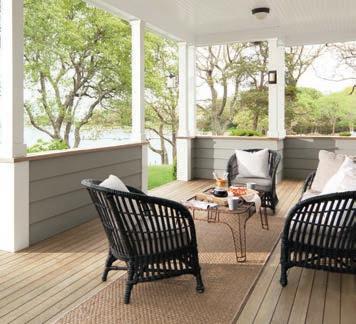

We’ve powered our communities for more than a century. And we’ll keep providing the reliable, low-cost electricity you depend on.


Paper
• Mail, office and school paper
• Magazines and catalogs
• Newspaper and inserts
• Phonebooks
Boxes
• Cardboard
• Cereal and cracker boxes
• Shoe boxes, gift boxes, electronics boxes
Glass
• Food and beverage bottle and jars

Metal

• Food and beverage cans

Plastic*
• Empty Water, soda and juice bottles
• Milk bottles
• Ketchup and condiment bottles
• Dishwashing and detergent bottles
• Shampoo, soap, and lotion bottles
• Yogurt, pudding and fruit cups
• Margarine, cottage cheese and other containers

• Produce, deli and take out containers
Packaging*
• Clear, rigid packaging from toys and electronics
*Look for this symbol - Only “containers/ bottles” with a 1 and 2 can be recycled in Beltrami County.


Cartons, plastic bags, film and wrap, plastic foam; Styrofoam™, food waste, paper cups and plates, glass dishes, drinking glasses, window glass and ceramics, trash, containers that held hazardous products; oil, antifreeze
